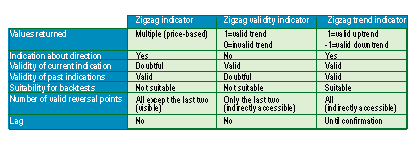INDICATORS
Validating Trends
The Zigzag Trend Indicator
by Spyros Raftopoulos
Zigzag is a powerful noise filter, but it's not without its problems. Here's a technique that incorporates the power of zigzag into a more valid and tradable indicator.
The popularity and usefulness of the zigzag indicator can be ascribed to three important characteristics. It is an effective noise filter; it graphically presents the main trend with great clarity; and it is still a very low-level indicator, in that its final interpretation of price is not filtered through one or more algorithms, but is based upon the price itself.
While these are important advantages, zigzag's main disadvantage is its dynamic nature. The indication of a trend's direction (provided by the "last leg" of zigzag) is revisable, and can therefore be misleading. Further, the indicator cannot be used in mechanical systems, since the backtesting of such systems should exclude any revisable parameters in order to be valid and accurate. I described the problem of the dynamic last leg in my previous S&C article, "Zigzag Validity." That article also presented my zigzag validity indicator, which can be used to validate the last leg.
This article introduces the zigzag trend indicator, which handles the dynamic nature of the zigzag indicator more efficiently. The zigzag trend approach solves the validity problem of the dynamic last leg by incorporating zigzag into a clearly tradable indicator.
THE ZIGZAG METHOD
The zigzag indicator filters out small and unimportant price movements. The reversal amount set by the user is the filter's threshold. Thus, if a reversal in price trend fails to follow through to this level, zigzag will revise itself; the apparent upswing or downswing will be filtered out and the previous trend will appear to continue without interruption. Once the price reversal has reached or exceeded the threshold, zigzag's last leg is no longer revisable.
These reversal criteria are the basis for the construction of zigzag validity and the new zigzag trend indicator, both of which check the validity of the last leg by calculating the difference between the last reversal point (peak or trough) and the current price.

Figure 1: Comparative table. A summary of the important characteristics of zigzag, zigzag validity, and zigzag trend.
...Continued in the November 2003 issue of Technical Analysis of STOCKS & COMMODITIES
Excerpted from an article originally published in the November 2003 issue of Technical Analysis of STOCKS & COMMODITIES magazine. All rights reserved. © Copyright 2003, Technical Analysis, Inc.
Return to November 2003 Contents